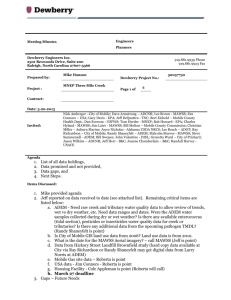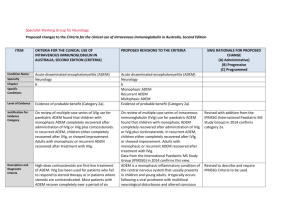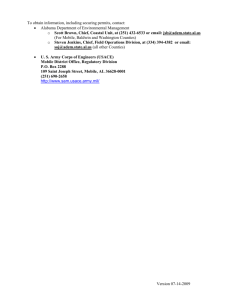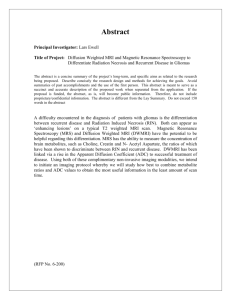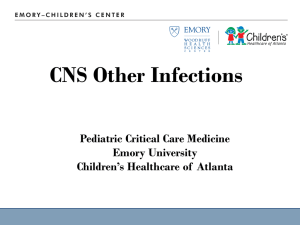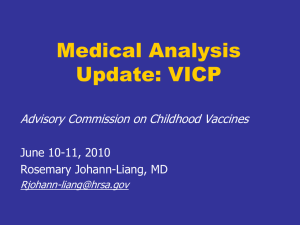Acute disseminated encephalomyelitis (ADEM)
advertisement
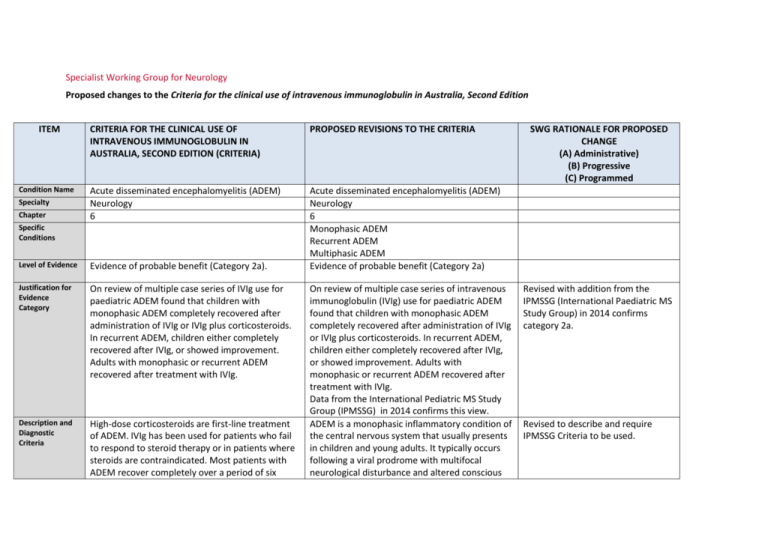
Specialist Working Group for Neurology Proposed changes to the Criteria for the clinical use of intravenous immunoglobulin in Australia, Second Edition ITEM Condition Name Specialty Chapter CRITERIA FOR THE CLINICAL USE OF INTRAVENOUS IMMUNOGLOBULIN IN AUSTRALIA, SECOND EDITION (CRITERIA) PROPOSED REVISIONS TO THE CRITERIA Acute disseminated encephalomyelitis (ADEM) Neurology 6 Acute disseminated encephalomyelitis (ADEM) Neurology 6 Monophasic ADEM Recurrent ADEM Multiphasic ADEM Evidence of probable benefit (Category 2a) Specific Conditions Level of Evidence Evidence of probable benefit (Category 2a). Justification for Evidence Category On review of multiple case series of IVIg use for paediatric ADEM found that children with monophasic ADEM completely recovered after administration of IVIg or IVIg plus corticosteroids. In recurrent ADEM, children either completely recovered after IVIg, or showed improvement. Adults with monophasic or recurrent ADEM recovered after treatment with IVIg. Description and Diagnostic Criteria High-dose corticosteroids are first-line treatment of ADEM. IVIg has been used for patients who fail to respond to steroid therapy or in patients where steroids are contraindicated. Most patients with ADEM recover completely over a period of six On review of multiple case series of intravenous immunoglobulin (IVIg) use for paediatric ADEM found that children with monophasic ADEM completely recovered after administration of IVIg or IVIg plus corticosteroids. In recurrent ADEM, children either completely recovered after IVIg, or showed improvement. Adults with monophasic or recurrent ADEM recovered after treatment with IVIg. Data from the International Pediatric MS Study Group (IPMSSG) in 2014 confirms this view. ADEM is a monophasic inflammatory condition of the central nervous system that usually presents in children and young adults. It typically occurs following a viral prodrome with multifocal neurological disturbance and altered conscious SWG RATIONALE FOR PROPOSED CHANGE (A) Administrative) (B) Progressive (C) Programmed Revised with addition from the IPMSSG (International Paediatric MS Study Group) in 2014 confirms category 2a. Revised to describe and require IPMSSG Criteria to be used. weeks from onset. There is no biological marker for ADEM. Diagnosis is by clinical recognition of the multifocal neurological disturbance and altered conscious state, with the typical MRI findings of demyelination. state. ADEM usually follows a monophasic course, but patients may experience recurrence of the initial symptom complex (recurrent ADEM) or a second episode of ADEM (multiphasic ADEM). The majority make a full recovery. ADEM is thought to have an autoimmune basis. Pathologic similarities to experimental allergic encephalomyelitis (EAE), an animal model of inflammatory demyelination, support this theory. It is postulated that a common antigen shared by an infectious agent and a myelin epitope results in an autoimmune response. Patients show multiple demyelinating lesions on magnetic resonance imaging (MRI) in the deep and subcortical white matter. The differential diagnosis includes other inflammatory demyelinating disorders, such as multiple sclerosis, optic neuritis and transverse myelitis. High-dose corticosteroids are first-line treatment of ADEM. IVIg has been used for patients who fail to respond to steroid therapy or in patients where steroids are contraindicated. Most patients with ADEM recover completely over a period of six weeks from onset. There is no biological marker for ADEM. Diagnosis is by clinical recognition of the multifocal neurological disturbance and altered conscious state, with the typical MRI findings of demyelination. The IPMSSG criteria must be used for diagnosis. National Blood Authority pg. 2 Diagnosis is required Note: Assessment by a neurologist is recommended, but not mandatory. Diagnosis must be verified Exclusion Criteria Indications Krupp, LB, Tardieu, M, Amato, MP, et al 2013, ‘International Pediatric Multiple Sclerosis Study Group criteria for pediatric multiple sclerosis and immune-mediated central nervous system demyelinating disorders: revisions to the 2007 definitions’, Multiple Sclerosis Journal, vol. 19, pp. 1261–1267. By which Yes Neurologist speciality No Now limited to Neurologists. By which speciality ADEM unresponsive to steroid therapy or where steroids are contraindicated (e.g. suspicion of CNS infection). Monophasic ADEM unresponsive to steroid therapy or where steroids are contraindicated. Recurrent or multiphasic ADEM unresponsive to steroid therapy or where steroid therapy has become intolerable or is contraindicated. Recurrent or multiphasic ADEM unresponsive to steroid therapy or where steroid therapy has become intolerable or is contraindicated, with assessment by a neurologist mandatory. Additional indication to support patient re-entry where relapse occurs within 6 months of trial off therapy. Relapse of patients with recurrent or multiphasic ADEM within six months of commencement of trial off immunoglobulin therapy. Qualifying Criteria ADEM unresponsive to steroid therapy or where steroids are contraindicated (e.g. suspicion of CNS infection). Note: Assessment by a neurologist is recommended, but not mandatory. National Blood Authority ADEM unresponsive to steroid therapy or where steroids are contraindicated. Diagnosis of ADEM consistent with IPMSSG criteria (confirmed on magnetic resonance imaging [MRI]) with recurrent symptoms arising from demyelination. pg. 3 SWG agreed that Monophasic ADEM Treatment is usually 4-6 weeks. IN some instances, up to three months treatment can be required. At 3 months there should be no new lesions with the patient getting better. AND No clinical response has been achieved with standard Steroid therapy or Steroid therapy is contraindicated. OR Recurrent or multiphasic ADEM unresponsive to steroid therapy, or where steroid therapy has become intolerable or is contraindicated, with assessment by a neurologist mandatory. Up to three doses may be requested where monophasic ADEM is extended and symptoms do not respond to a first treatment. After three months, an alternative diagnosis should be considered. Recurrent or multiphasic ADEM unresponsive to steroid therapy or where steroid therapy has become intolerable or is contraindicated, with assessment by a neurologist mandatory. Diagnosis of recurrent or multiphasic ADEM (as per IPMSSG criteria) (Krupp et al. 2013). AND No clinical response has been achieved following standard steroid therapy or steroid therapy is contraindicated or intolerable. 1Krupp, LB, Tardieu, M, Amato, MP, et al 2013, ‘International Pediatric Multiple Sclerosis Study Group criteria for pediatric multiple sclerosis and immune-mediated central nervous system demyelinating disorders: revisions to the 2007 definitions’, Multiple Sclerosis Journal, vol. 19, pp. 1261–1267. Relapse of patients with recurrent or multiphasic ADEM within six months of commencement of trial off immunoglobulin therapy. National Blood Authority pg. 4 Recurrent ADEM will have different new lesions – the patient would be eligible for further treatment under the other indication. Multi-phasic has a grumbling course with different lesions and symptoms. Criteria extended to require diagnosis to be MRI proven and patient to have a failed clinical response to steroids or stated contraindication reason Diagnosis of recurrent or multiphasic ADEM (as per IPMSSG criteria) (Krupp et al. 2013). AND Evidence of deterioration in symptoms. AND Relapse occurs within six months of the last immunoglobulin (Ig) dose. 1Krupp, LB, Tardieu, M, Amato, MP, et al 2013, ‘International Pediatric Multiple Sclerosis Study Group criteria for pediatric multiple sclerosis and immune-mediated central nervous system demyelinating disorders: revisions to the 2007 definitions’, Multiple Sclerosis Journal, vol. 19, pp. 1261–1267. Review Criteria Monophasic ADEM unresponsive to steroid therapy or where steroids are contraindicated. No review is required. Further doses of Ig can be requested as required for patients with extended monophasic ADEM. Recurrent or multiphasic ADEM unresponsive to steroid therapy or where steroid therapy has become intolerable or is contraindicated, with assessment by a neurologist mandatory. Review Preamble Objective evidence of improvement in relapse rate in comparison to pre-treatment levels is required for reauthorisation. National Blood Authority pg. 5 Response must be demonstrated after 6 months treatment for reauthorisation. Trial off therapy must be undertaken after 12 months treatment. If patients with Recurrent or Multi-phasic ADEM relapse within 6 months of ceasing Ig treatment, reentry is defined with requirement for further response at review. Six-monthly review by a neurologist is required for recurrent or multiphasic ADEM. On review of an initial authorisation period After six months treatment, patients demonstrating improvement in ADEM symptoms, including no new lesions on MRI and a stabilised clinical course, are eligible for a further six months of treatment. After that time, a trial off Ig therapy should be commenced. If the patient relapses within six months of ceasing (with clinical and radiological evidence of relapse), patients may qualify under that indication. The aim should be to use the lowest dose possible that achieves the appropriate clinical outcome for each patient. Objective evidence of improvement in relapse rate in comparison to pre-treatment levels. Six-monthly review by a neurologist is required for recurrent or multiphasic ADEM. Relapse of patients with recurrent or multiphasic ADEM within six months of commencement of trial off Immunoglobulin therapy. Review Preamble Objective evidence of improvement in relapse rate in comparison to pre-treatment levels is required for reauthorisation. Six-monthly review by a neurologist is required for recurrent or multiphasic ADEM. National Blood Authority pg. 6 On review of an initial authorisation period After 6 months Ig treatment, patients demonstrate improvement in ADEM symptoms including no new lesions on MRI and stabilised clinical course. OR On review of a continuing authorisation period SWG confirmed that treatment cessation should be considered at 12 months. If the patient relapses, (with clinical and radiological evidence of relapse), re-entry should be supported. Patients demonstrate improvement in ADEM symptoms, including no new lesions on MRI and stabilised clinical course. AND A trial off Ig therapy is planned or a valid reason provided as to why a trial is not being planned. SWG advised that even relapsed patients should not remain on Ig indefinitely. Cessation should be considered annually with weaning off therapy and a trial off therapy. Dose Induction: 2 g/kg in 2 to 5 divided doses. Maintenance dose: For recurrent or multiphasic ADEM only: 0.4–2 g/kg, 4–6 weekly. Aim for the minimum dose to maintain optimal functional status and prevent relapses. National Blood Authority Monophasic ADEM unresponsive to steroid therapy or where steroids are contraindicated Up to three doses (induction + two maintenance doses) may be used for extended monophasic pg. 7 Monophasic is usually treated by a one off dose but the underlying disease may continue for 3 months – therefore treatment may need to continue for 3/12. Up to 2 In recurrent or multiphasic ADEM, assessment by a neurologist is mandatory. ADEM. After three months, if symptoms persist, an alternative diagnosis should be considered. additional doses (maintenance) can be requested. Dosing above 1 g/kg per day is contraindicated for some IVIg products. Induction - Up to 2 g/kg in 2 to 5 divided doses. Maintenance - For extended monophasic ADEM: 0.4–2 g/kg, 4-–6 weekly. After three months, if symptoms persist, an alternative diagnosis should be considered. If further treatment is needed, then an alternate diagnosis and review is mandatory. Refer to the current product information sheet for further information. The aim should be to use the lowest dose possible that achieves the appropriate clinical outcome for each patient. The aim should be to use the lowest dose possible that achieves the appropriate clinical outcome for each patient. Dosing above 1 g/kg per day is contraindicated for some IVIg products. Refer to the current product information sheet for further information. Recurrent or multiphasic ADEM unresponsive to steroid therapy or where steroid therapy has become intolerable or is contraindicated, with assessment by a neurologist mandatory. Induction - Up to 2 g/kg in 2 to 5 divided doses kg as a single dose. Maintenance - For recurrent or multiphasic ADEM: 0.4–2 g/kg, 4–6 weekly. The aim should be to use the lowest dose National Blood Authority pg. 8 possible that achieves the appropriate clinical outcome for each patient. Dosing above 1 g/kg per day is contraindicated for some IVIg products. Refer to the current product information sheet for further information. Relapse of patients with recurrent or multiphasic ADEM within six months of commencement of trial off immunoglobulin therapy. Induction - Up to 2 g /kg in 2–5 divided doses. Maintenance -For recurrent or multiphasic ADEM: 0.4–2 g/kg, 4–6 weekly. The aim should be to use the lowest dose possible that achieves the appropriate clinical outcome for each patient. Dosing above 1 g/kg per day is contraindicated for some IVIg products. Refer to the current product information sheet for further information. POTENTIAL OPERATIONAL IMPACT Given that ADEM is quite rare, diagnosis is already likely to be made by neurologists. Where patients are in the care of a general physician, transfer will be required to a neurologist. It is important that patients will have given informed consent to Ig treatment, which includes understanding that a measurable National Blood Authority pg. 9 clinical response will determine continuing eligibility. Recurrent and Multi-phasic ADEM patients not demonstrating a satisfactory response will cease therapy at 6 months, and all patients will trial off at 12 months. POTENTIAL IMPACT ON DEMAND Patient Numbers 2013-14 41 patients Usage 2013-14: <1% Usage 2013/14 Given the few patients with this condition it is unlikely that there will be any significant impact on demand, although usage by this group of patients may be reduced due to the newly defined timeframes for treatment period. POTENTIAL IMPACT ON COST Current cost Anticipated reduction in cost, if any Marginal Marginal = borderline or unchanged from current cost Minor = decrease by $500K - $1.99M from current cost Major = decrease $2M+ from current cost BIBLIOGRAPHY Andersen, JB, Rasmussen, LH, Herning, M, et al 2001, ‘Dramatic improvement of severe acute disseminated encephalomyelitis after treatment with intravenous immunoglobulin in a three-year-old boy’, Developmental Medicine & Child Neurology, vol. 43, no. 2, pp. 136–8. Feasby, T, Banwell, B, Benstead, T, et al 2007, ‘Guidelines on the use of intravenous immune globulin for neurologic conditions’, Transfusion Medicine Reviews, vol. 2, no. 2, suppl. 1, pp. S57–107. Finsterer, J, Grass, R, Stollberger, C, et al 1998, ‘Immunoglobulins in acute, parainfectious, disseminated encephalomyelitis’, Clinical Neuropharmacology, vol. 21, pp. 258–61. Hahn, JS, Siegler, DJ & Enzmann, D 1996, ‘Intravenous gammaglobulin therapy in recurrent acute disseminated encephalomyelitis’, Neurology, vol. 46, no. 4, pp. 1173–4. Krupp, LB, Tardieu, M, Amato, MP, et al 2013, ‘International Pediatric Multiple Sclerosis Study Group criteria for pediatric multiple sclerosis and immunemediated central nervous system demyelinating disorders: revisions to the 2007 definitions’, Multiple Sclerosis Journal, vol. 19, pp. 1261–1267. Kleiman, M & Brunquell, P 1995, ‘Acute disseminated encephalomyelitis: response to intravenous immunoglobulin?’ Journal of Child Neurology, vol. 10, no. 6, pp. 481–3. Marchioni, E, Marinou-Aktipi, K, Uggetti, C, et al 2002, ‘Effectiveness of intravenous immunoglobulin treatment in adult patients with steroid-resistant National Blood Authority pg. 10 monophasic or recurrent acute disseminated encephalomyelitis’, Journal of Neurology, vol. 249, no. 1, pp. 100–4. Mariotti, P, Batocchi, AP, Colosimo, C, et al 2003, ‘Multiphasic demyelinating disease involving central and peripheral nervous system in a child’, Neurology, vol. 60, no. 2, pp. 348–9. Nishikawa, M, Ichiyama, T, Hayashi, T, et al 1999, ‘Intravenous immunoglobulin therapy in acute disseminated encephalomyelitis’, Paediatric Neurology, vol. 21, no. 2, pp. 583–6. Pittock, SJ, Keir, G, Alexander, M, et al 2001, ‘Rapid clinical and CSF response to intravenous gamma globulin in acute disseminated encephalomyelitis’, European Journal of Neurology, vol. 8, no. 6, p. 725. Pradhan, S, Gupta, RP, Shashank, S, et al 1999, ‘Intravenous immunoglobulin therapy in acute disseminated encephalomyelitis’, Journal of the Neurological Sciences, vol. 165, no. 1, pp. 56–61. Revel-Vilk, S, Hurvitz, H, Klar, A, et al 2000, ‘Recurrent acute disseminated encephalomyelitis associated with acute cytomegalovirus and Epstein-Barr virus infection’, Journal of Child Neurology, vol. 15, no. 6, pp. 421–4. Sahlas, DJ, Miller, SP, Guerin, M, et al 2000, ‘Treatment of acute disseminated encephalomyelitis with intravenous immunoglobulin’, Neurology, vol. 54, no. 6, pp. 1370–2. END OF DOCUMENT National Blood Authority pg. 11
